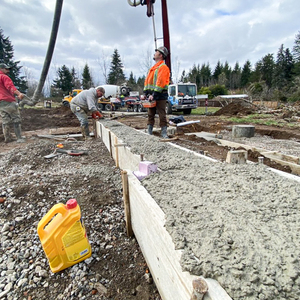
With COP28 now in the books, the question—or at least one of the questions—on everyone’s minds is, can we still limit global warming to 1.5°C? This was the internationally agreed upon benchmark to prevent potentially irreversible effects of climate change, established at COP21 in Paris in 2015. We’ve already reached 1.2° above preindustrial times, and it looks as though 2023 is on track to surpass record levels for global carbon emissions from burning coal, oil, and gas, according to the Global Carbon Project. At our current rate, we’ll reach 1.5° by 2030 or sooner.
Small gestures add up, and in the green building arena, those gestures comprise everything from electrifying and building smaller to specifying regenerative materials that support regional economies. But even the most well-intentioned among us must concede that, if keeping to 1.5° is anywhere near feasible, we need big gestures from big global players, like real estate developers, retailers, and financial institutions. And we need them in large numbers, and we need them yesterday.
Providing new guidance for the building sector
The Science Based Targets initiative (SBTi) recently unveiled a draft for pilot testing of its new target-setting guidance for the building sector, set to go into effect in the first half of 2024. SBTi is a partnership between the Carbon Disclosure Project (CDP), the UN Global Compact, World Resources Institutes (WRI), and World Wide Fund for Nature (WWF). The organization currently has published guidance and Sector Decarbonization Approaches for aluminum, concrete, steel, power, and select other sub-categories that are tied either directly or indirectly to the built environment. But until recently, buildings and their whole life cycle impacts were left out.
This guidance is intended to support companies with a substantial building portfolio in setting 1.5°-aligned operational and embodied emissions targets. In other words, if you’re a corporation that occupies and operates a lot of floor space, a verified set of criteria will soon be available that enables you to track and report Scope 1, 2, and 3 emissions in greater detail. The guidance details decarbonization pathways for project and design requirements to align with corporate sustainability commitments, which are too often rife with greenwashing platitudes.
“Science Based Targets has been around for a bit, and many of the big corporate movers have coalesced around it as the gold standard for voluntary carbon commitments,” says Kathleen Hetrick, an engineer with Buro Happold, which sat on SBTi’s expert advisory group in developing the pilot guidance.
Industry standards like LEED or the Living Building Challenge reflect the design community’s best intentions, but “it can be difficult to get clients to buy in,” Hetrick says. “With [SBTi], the new guidance is specific to large building portfolios” and it touches on all phases of carbon output and budgeting, “moving away from fossil fuels for power and heating and cooling by 2030.” She adds, “this is the strongest signal we’re going to see of large companies committing to Science Based Targets, and we’re finally going to start seeing this kind of top-down pressure, which is exciting.”
Making a dent
Globally, the building sector contributes more than one-third (approximately 40%) of energy consumption and GHG emissions. By one estimate, global CO2 emissions surpassed 36.8 gigatons (GT) in 2022, the highest levels on record, although “less than initially feared,” according to the International Energy Agency (IEA). Of that, 3 GT of CO2e are tied to direct building emissions, 9.8 GT of CO2e for indirect emissions (electricity and heat consumption), and 3.5 GT from materials. Further, built floor area is on track to increase by approximately 75% in the next three decades. Conclusion: if no significant decarbonization efforts take hold within the global building sector, humankind is indeed on an unsustainable trajectory.
Even for a self-described “radical,” Hetrick remains cautiously optimistic. “The guidance that came out of this is a huge step in the right direction,” she says. “If companies commit to banning new fossil fuel connections, adopting operational carbon targets, per CRREM (Carbon Risk Real Estate Monitor), and setting new embodied carbon targets for A1-A5,” referring to product and construction-related phases within a building’s life cycle, “I do believe we would be able to address that 40% of emissions. It would have huge network effects for suppliers and send strong market signals for low-carbon products.”
Corporate carbon budgeting has long suffered from blind spots, particularly as it concerns embodied carbon and scope 2 and 3 emissions. Even in the post-Paris Agreement era, many corporate entities got a free pass because they could claim, with some legitimacy, that the tools and methodologies for tracking embodied carbon were inadequate, or that designing for energy efficiency wasn’t a verifiable metric for economic success.
“Companies should no longer be able to get away with this,” Hetrick says. This guidance touches on “every type of company and every region. It’s hugely powerful.” SBTi’s building sector guidance does address different user categories, broken up by developer, owner-occupier, owner-lessor, property manager, and so forth; it’s not a one-size-fits-all approach. For instance, emissions target setting and carbon budgets for corporations like JLL and ARUP (to cite two other expert advisory group members) will look somewhat different and are largely contingent on building type, use, and geography. That said, according to the guidance, targets are set by assuming that “all companies converge to the same [carbon] intensity level as the sector average in the long term.” The built environment comprises a vastly complex sector, but the guidance aptly points out that “all users within this sector engage with one ‘product’, i.e. buildings.” In other words, decarbonization pathways may diverge based on external factors, but the finish line is the same.
Preparing for a low-carbon future
Science Based Targets are a matter of planning; they indicate both quantities and timelines for corporate entities to devise carbon budgets that are in keeping with the 1.5° threshold. (Measuring current operational performance isn’t within the scope of the building sector guidance.) When companies devise their timeframes, the SBTi specifies both near-term (5-10 years) and long-term (prior to 2050) pathways en route to a net-zero carbon future. Ultimately, the yardstick for success relies on those large corporations aligning their capital planning with the 1.5° ceiling, while removing a lot of the guess work and greenwashing from the equation. So-called corporate responsibility is now, essentially, quantifiable.
As comprehensive as this new guidance is, Hetrick points out that the design community of AEC firms is not covered as part of the new guidance. That may seem like a blind spot, but seen another way, the onus is now on those firms’ clients to adjust their operational targets and look at their regional building supply chains on a holistic scale. “It shouldn’t stop AEC companies from taking stock and understanding their impact now. Once you understand your baseline, you can start strategizing how to improve. And luckily with this upcoming building sector guidance, clients will be demanding it.”
And with new code and regulatory requirements either in place or in development across various nations and international agencies, “this new guidance helps companies get a handle on streamlining [everything] right in time,” she says. “Everything is moving in the right direction.”
________________________________________________________________________
Justin R. Wolf is a Maine-based writer who covers green building trends and energy policy.
Weekly Newsletter
Get building science and energy efficiency advice, plus special offers, in your inbox.















5 Comments
Justin,
Thank you for mentioning greenwashing and using the word rife along with it. We are finding that a lot of carbon trading was bogus and just kicked the can down the road. Putting a curb on global warming should not come at the expense of those already disenfranchised. The big and negative global impact companies should, through taxation, make life better for the masses. The denialism today on climate change in every facet of business is astounding, counterclockwise is the new clockwise.
Last year I contacted 2 groups touting themselves as experts on the how to and the measurement of terrestrial carbon. No response from either. I am very interested in terrestrial carbon sequestration because it is real and will need to be part of our regreening of mother Earth. Not only can we sequester CO2 deep into the subsoil but it improves the % of organic matter and makes soil more productive and less erosive. No downside to this, only upside. Adopt a real carbon farmer, they are out there.
Very interesting. I haven't done much research into this arena, but your comment is all the cause I need. Much thanks!
Justin,
"Small gestures add up, and in the green building arena, those gestures comprise everything from electrifying and building smaller to specifying regenerative materials that support regional economies."
Unfortunately, I've seen no evidence that they make any appreciable difference. There may be a good moral argument for doing them, but I haven't seen a practical one.
Thanks, Malcolm, but please note that the remainder of the paragraph from which you quoted actually supports your first point. I do disagree, however, with your point about there not being a practical argument ... is it not practical for a homeowner to stop burning expensive propane in place of electrifying one's home (as one example)?
Here is the news.
https://www.theguardian.com/us-news/2024/feb/19/new-york-lobbyists-climate-crisis
Log in or create an account to post a comment.
Sign up Log in